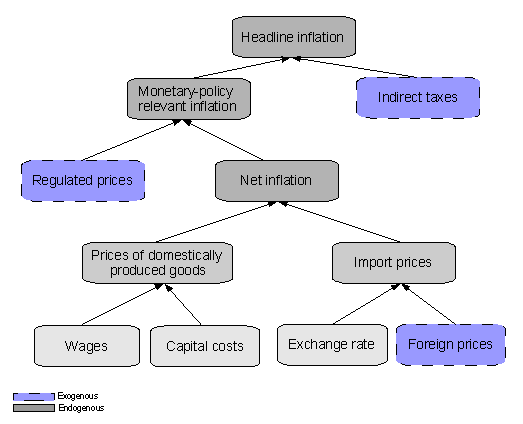
In the g3 model, consumer prices are determined by prices of goods produced in the home economy and prices of imported goods. Prices of domestically produced goods (domestic prices) and prices of imported goods (import prices) are sticky in the home currency and comprise a mark-up on nominal marginal costs.
Labour and capital costs are the main costs for the production of domestic goods. The price of goods in the foreign currency and the nominal exchange rate constitute costs for imported goods. Given the price rigidities, changes in nominal marginal costs pass through to final prices with a lag. Firms cannot change prices every quarter and spread the price response to a change in nominal marginal costs over time to the detriment of their mark-ups (profit margins), mainly because of the price elasticity of demand.
Cost pressures on final prices are characterised by real marginal costs, or the real marginal cost gap. Real marginal costs are measured as nominal marginal costs divided by the production price, and are thus the inverse of the mark-up. Growth in a producer’s nominal marginal costs without a commensurate increase in the final price results in a decline in the mark-up, i.e. an increase in real marginal costs. Growth in real marginal costs, or a positive real marginal cost gap, exerts upward cost pressures on prices. We speak of a real marginal cost gap because it refers to the deviation from the required level of real marginal costs and thus from the required mark-up. Pricing is affected not only by the current level of nominal or real marginal costs, but also by their expected evolution.
Import prices and domestic prices of intermediate goods constitute the production costs of final consumption goods. Prices of final consumption goods are again sticky and changes thereto represent net inflation. The real marginal cost gap in the consumption goods sector is therefore the main indicator of overall cost pressures in the economy.
Net inflation, together with regulated prices and changes to indirect taxes, determines headline consumer inflation. The monetary authority targets monetary-policy relevant inflation, i.e. headline consumer price inflation adjusted for the first-round effects of changes to indirect taxes.
In terms of predicting inflation, the future evolution of indirect taxes, regulated prices and foreign producer prices are treated as exogenous, so they are not modelled by internal model mechanisms.
The pricing structure in the g3 model together with the price stickiness cascade allows the observed data and the cyclical behaviour of the economy to be replicated.